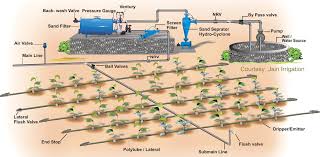In India, the irrigated area contains concerning 36 per cent of the web sown location. Presently, the agricultural sector make up regarding 83 per cent of all water makes use of. The remaining usages include 5, 3, 6 and also 3 per cent specifically, by residential, commercial and power sectors as well as other customers. Raising competition with the different water individuals in the future would restrict the water availability for expanding irrigated area. In conventional surface area watering techniques, the losses in water conveyance and application are huge. These losses can be significantly decreased by taking on drip as well as lawn sprinkler irrigation methods. Among all the watering approaches, the drip irrigation is one of the most efficient and it could be practised in a huge range of crops, particularly in vegetables, orchard crops, florals as well as hacienda plants. In drip irrigation, water is applied near the plant origin via emitters or drippers, on or here the soil surface, at a reduced price differing from 2 – 20 lit res per hour. The dirt wetness is maintained an optimum level with constant irrigations. Leak irrigation results in a quite high water application effectiveness of concerning 90-95 per cent.
History of Drip Irrigation
Making use of drip watering can be mapped back to the ancient customized in certain parts of India of irrigating a tulsi plant kept in the yard. During the summertime, the plant was watered by a hanging bottle having water and a minute opening at its bottom to permit the dripping of water on the plant. The tribal farmers of Arunachal Pradesh practised a primitive kind of drip watering system using a slender bamboo as the channel for water flow. The use of drippers in sub-surface irrigation network wased initially explore in Germany in 1869. The obvious growth of the petrochemical industry during as well as after the 1950s helped with manufacturing of plastic water pipes at a cost more affordable than the cost of metal or cement concrete pipes. Plastic water pipes are convenient for water carriage under stress and also the plastic material are easily developed into the preferred arrangement. These attributes of plastic made the field-scale usage of drip watering practicable. The drip system was established for area crops in Israel in the very early 1960s and also in Australia and North America in the late 1960s. The area under drip irrigation system in the UNITED STATE is about 1 M ha, followed by India, Spain, Israel, and so on.
. In India, there has actually been an incredible growth in the area under drip watering throughout the last 15 years. At present, around 3.51 akh ha location is under drip irrigation with the efforts of the Government of India, while it was only 40 ha in 1960. Maharashtra (94,000 ha), Karnataka (66,000 ha) as well as Tamil Nadu (55,000 ha) are several of the states where large areas have actually been brought under drip irrigation. Lots of crops are irrigated by the drip method in India with the tree crops inhabiting the maximum percentage of the total area under drip watering, followed by vine crops, veggies, field plants, blossoms and also other plants.


